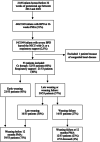Factors of late respiratory support or oxygen weaning in infants with bronchopulmonary dysplasia
- PMID: 39451000
- PMCID: PMC11740655
- DOI: 10.1002/ppul.27367
Factors of late respiratory support or oxygen weaning in infants with bronchopulmonary dysplasia
Abstract
Objectives: Bronchopulmonary dysplasia (BPD) is the most common complication in preterm infants. This study aimed at identifying factors associated with early or with late or weaning failure from respiratory support or oxygen (O2) in preterm infants with BPD requiring respiratory support or O2 therapy after discharge from the neonatal intensive care unit (NICU).
Methods: This retrospective study was conducted in the NICU of a tertiary hospital, in infants born before 32 weeks of gestation between 2012 and 2021, and discharged from the NICU with a respiratory support (tracheostomy [TT], invasive ventilation [IV], Non-IV [NIV], continuous positive airway pressure [CPAP], high flow nasal canula [HFNC]) or O2 therapy for BPD. Univariate and multivariate analyses were performed to identify factors associated with early weaning (before 6 months postmenstrual age [PMA]) or late (after 6 months PMA) and weaning failure.
Results: Among the 53 infants included (2% TT, 2% IV, 11% NIV, 25% CPAP or HFNC, 60% O2 at NICU discharge), 23 (43%) were weaned from respiratory support or O2 before 6 months PMA and 39 (73%) before 12 months PMA. IV duration during NICU stay and postnatal steroid treatment were identified as factors associated with a late or weaning failure (OR 1.03, p = .04 and OR 4.11, p = .023, respectively).
Conclusion: In this study, nearly half of preterm infants with severe BPD were weaned from respiratory support or O2 before 6 months PMA. IV duration and postnatal steroid treatment during NICU stay were associated with a late or weaning failure.
Keywords: bronchopulmonary dysplasia; infants; prematurity; respiratory support; weaning.
© 2024 The Author(s). Pediatric Pulmonology published by Wiley Periodicals LLC.
Conflict of interest statement
The authors declare no conflict of interest.
Figures



References
MeSH terms
Grants and funding
LinkOut - more resources
Full Text Sources
Medical

